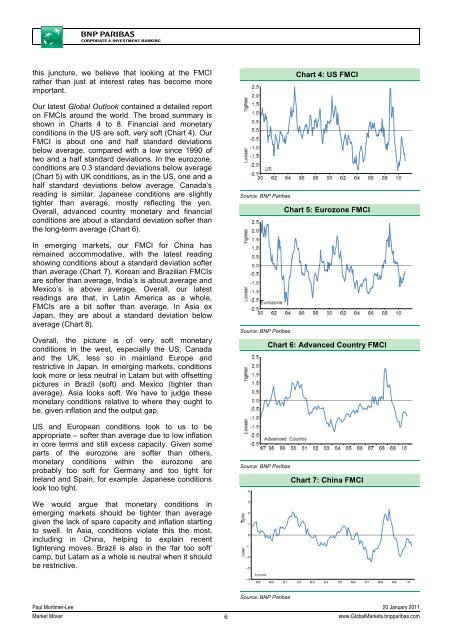Market Economics | Interest Rate Strategy - BNP PARIBAS ...
Market Economics | Interest Rate Strategy - BNP PARIBAS ...
Market Economics | Interest Rate Strategy - BNP PARIBAS ...
Create successful ePaper yourself
Turn your PDF publications into a flip-book with our unique Google optimized e-Paper software.
this juncture, we believe that looking at the FMCI<br />
rather than just at interest rates has become more<br />
important.<br />
Our latest Global Outlook contained a detailed report<br />
on FMCIs around the world. The broad summary is<br />
shown in Charts 4 to 8. Financial and monetary<br />
conditions in the US are soft, very soft (Chart 4). Our<br />
FMCI is about one and half standard deviations<br />
below average, compared with a low since 1990 of<br />
two and a half standard deviations. In the eurozone,<br />
conditions are 0.3 standard deviations below average<br />
(Chart 5) with UK conditions, as in the US, one and a<br />
half standard deviations below average. Canada’s<br />
reading is similar. Japanese conditions are slightly<br />
tighter than average, mostly reflecting the yen.<br />
Overall, advanced country monetary and financial<br />
conditions are about a standard deviation softer than<br />
the long-term average (Chart 6).<br />
In emerging markets, our FMCI for China has<br />
remained accommodative, with the latest reading<br />
showing conditions about a standard deviation softer<br />
than average (Chart 7). Korean and Brazilian FMCIs<br />
are softer than average, India’s is about average and<br />
Mexico’s is above average. Overall, our latest<br />
readings are that, in Latin America as a whole,<br />
FMCIs are a bit softer than average. In Asia ex<br />
Japan, they are about a standard deviation below<br />
average (Chart 8).<br />
Overall, the picture is of very soft monetary<br />
conditions in the west, especially the US, Canada<br />
and the UK, less so in mainland Europe and<br />
restrictive in Japan. In emerging markets, conditions<br />
look more or less neutral in Latam but with offsetting<br />
pictures in Brazil (soft) and Mexico (tighter than<br />
average). Asia looks soft. We have to judge these<br />
monetary conditions relative to where they ought to<br />
be, given inflation and the output gap.<br />
US and European conditions look to us to be<br />
appropriate – softer than average due to low inflation<br />
in core terms and still excess capacity. Given some<br />
parts of the eurozone are softer than others,<br />
monetary conditions within the eurozone are<br />
probably too soft for Germany and too tight for<br />
Ireland and Spain, for example. Japanese conditions<br />
look too tight.<br />
Source: <strong>BNP</strong> Paribas<br />
Source: <strong>BNP</strong> Paribas<br />
Source: <strong>BNP</strong> Paribas<br />
Chart 4: US FMCI<br />
Chart 5: Eurozone FMCI<br />
Chart 6: Advanced Country FMCI<br />
Chart 7: China FMCI<br />
We would argue that monetary conditions in<br />
emerging markets should be tighter than average<br />
given the lack of spare capacity and inflation starting<br />
to swell. In Asia, conditions violate this the most,<br />
including in China, helping to explain recent<br />
tightening moves. Brazil is also in the ‘far too soft’<br />
camp, but Latam as a whole is neutral when it should<br />
be restrictive.<br />
Source: <strong>BNP</strong> Paribas<br />
Paul Mortimer-Lee 20 January 2011<br />
<strong>Market</strong> Mover<br />
6<br />
www.Global<strong>Market</strong>s.bnpparibas.com

















